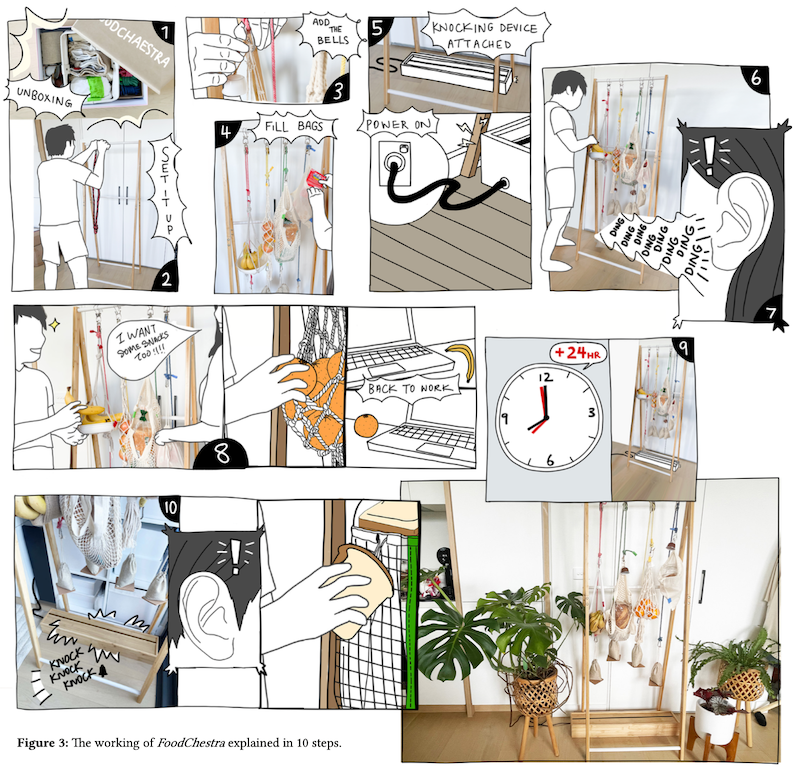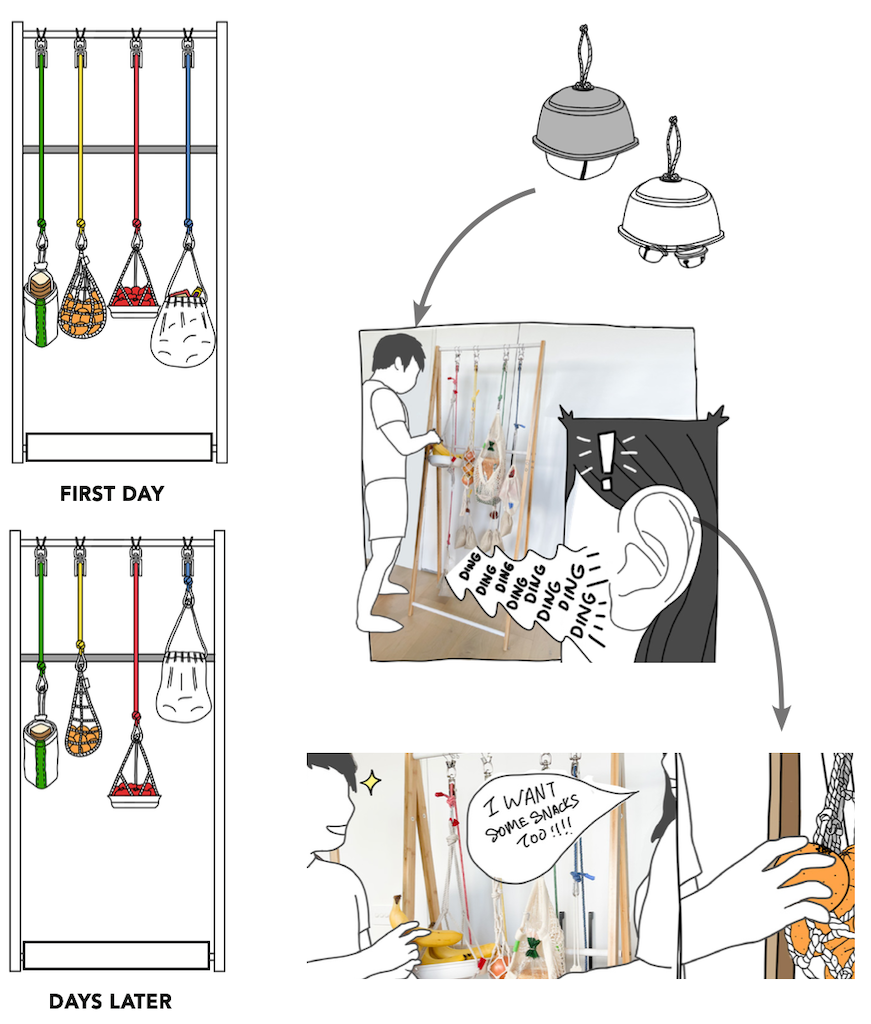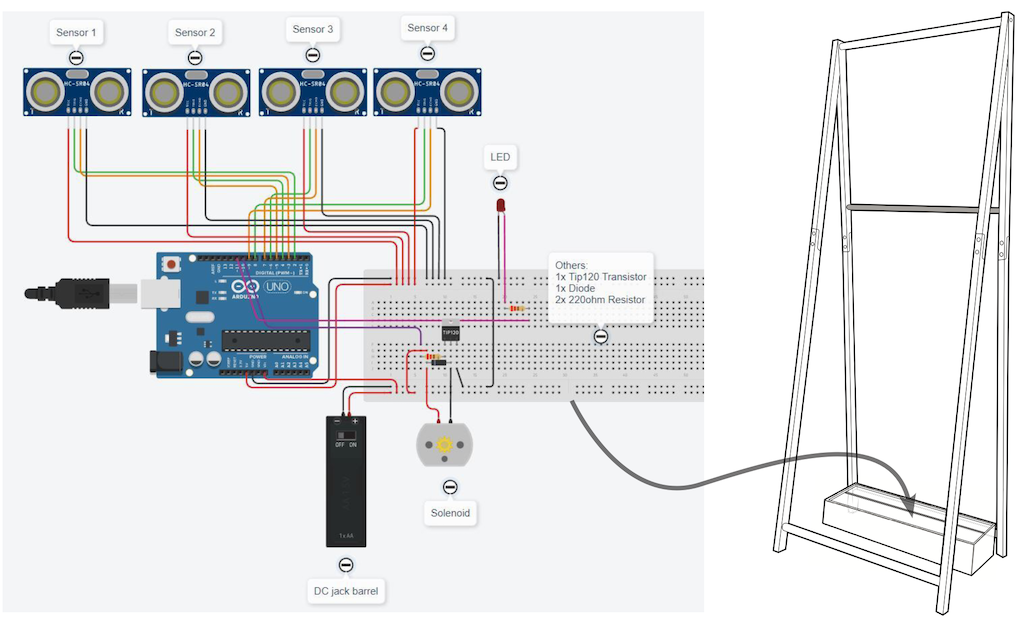
FoodChestra
Domestic food waste Multimodal feedback Human-Food InteractionThis research project is focused on the design of an open food pantry system to help users understand and reflect on their domestic food storage and consumption practices. We have designed FoodChestra, a smart open food pantry that displays perishable food items in open to invite user’s attention. The food items are hung in specially designed bags arranged on an open style structure to allow multimodal interactions with the food. The system also presents a timely reminder when a food item remains untouched for 24 hours. FoodChestra creates opportunities for both shared and self-reflection on different phases of food consumption including shopping, consumption and disposal in urban shared households.
Made with by Yi Ling Tai, Jason Ng, Nandini Pasumarthy, Deepti Aggarwal, & Rohit Ashok Khot
Yi Ling Tai, Jason Ng, Nandini Pasumarthy, Deepti
Aggarwal, Rohit Ashok Khot. 2023.
Rethinking Domestic Food Consumption through a
Multi-modal Open Pantry.
In Proceedings of the Seventeenth International
Conference on Tangible, Embedded, and Embodied
Interaction (TEI'23), ACM, 1-15.
FoodChestra TEI 2023 presentation
Simple.
According to the Australian Food Bank, Australian households account for one-third of the food waste in the whole food cycle. Fast paced urban lifestyle and the prevalent use of quick, ‘on-the-go’ food practices results in more food purchases that eventually go to waste if not eaten on time. Additionally, as per the 2019 Fight Food Waste CRC report, the top five most wasted food items in an urban household were fresh produce such as vegetables, bread, fruits, and meat that account for more than 40% of domestic food waste.
Grounded.
According to the Australian Food Bank, Australian households
account for one-third of the food waste in the whole food
cycle. Fast paced urban lifestyle and the prevalent use of
quick, ‘on-the-go’ food practices results in more food
purchases that eventually go to waste if not eaten on time.
Additionally, as per the 2019 Fight Food Waste CRC report,
the top five most wasted food items in an urban household
were fresh produce such as vegetables, bread, fruits, and
meat that account for more than 40% of domestic food waste.
Issues of domestic food waste and disposal are complex as
the cause and effect are not directly visible to the general
audience. They require effective motivational strategies to
engage individuals to reflect on their food practices first
and the change in their behaviour may happen gradually over
time. For instance, in early stages of change, users may
require strategies that can help them in overcoming
reluctance or inadequate motivation through gradual increase
in their awareness about themselves and their food related
behaviours. Over time, individuals can then re-evaluate
their activities and take necessary action. FoodChestra is a
step towards this direction to enable gradual change in
behaviour through a domestic open display of one’s food
storage and consumption.
Contemporary.
The design of FoodChestra is inspired by the current trends of open closets and traditional food storage practices of hanging food in the open. Open closets not only serve as a form of self- expression where users can show-off their minimal yet trendy collection, but it also creates a social persuasion on adopting a minimalist lifestyle and attitude. We also aimed to make our design playful and inviting to encourage users to interact with it naturally and should not remain purely educational.

The paper addressed food-waste challenges in a designerly and playful way. The pictorial does an excellent job showing its contribution through visuals and the narrative is very easy to follow. I enjoyed reading about FoodChestra and all the design implications present along its development. I think the TEI community would benefit a lot from this work since it opens up new design opportunities for interaction design that addresses issues such as food waste.
Annoymous Reviewer
ACM TEI 2023




